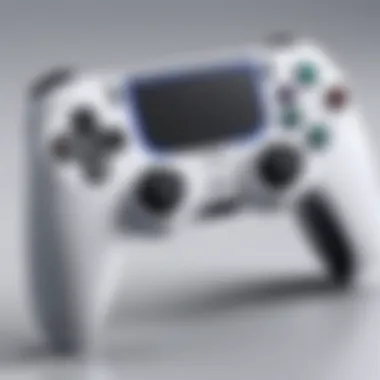Understanding the PS5 Controller: A Comprehensive Overview


Intro
The PlayStation 5 controller is more than just a peripheral; it is a pivotal element of contemporary gaming. With the release of the PS5, Sony introduced numerous advancements that enhance user interaction and immerse players in the gaming world, making the controller essential for both casual and hardcore gamers. This article delves into the nuances of the PS5 controller, examining its innovative design, advanced technological features, and the overall impact it has had on gameplay.
The PS5 controller, known officially as the DualSense, integrates various improvements from its predecessor, the DualShock 4. Its unique features include adaptive triggers, haptic feedback, and an ergonomic structure all designed to enhance the physical aspects of gameplay. These innovations not only redefine how players control their games but also elevate the emotional connection players feel within virtual environments.
As the gaming landscape evolves, understanding the significance of the PS5 controller helps enthusiasts appreciate its contributions. The insights provided will include comparisons with earlier models, user experiences, and an exploration of potential future developments in gaming hardware. Let’s embark on this comprehensive journey to understand the PS5 controller and its role in shaping modern gaming.
Intro to the PS5 Controller
The PlayStation 5 controller, also known as the DualSense, marks a significant development in gaming technology. It is essential to understand this controller as it plays a pivotal role in shaping the gaming experience on the PS5 console. The advancements incorporated in the DualSense enhance immersion and interaction, making the controller a vital piece of equipment for gamers.
This section delves into two critical perspectives:
- Historical Context: Understanding the origins and background that led to the current state of gaming controllers.
- Evolution of Gaming Controllers: An exploration of how controllers have transformed over the decades, paving the way for the PS5 controller.
By analyzing these aspects, readers can appreciate not only the technical features of the PS5 controller but also its significance within the broader landscape of gaming evolution.
Design and Aesthetics
The design and aesthetics of the PS5 controller play a pivotal role in shaping the user's experience. Not only does a well-thought-out design enhance the functionality of the device, but it also contributes to the overall appeal and connection gamers have with their consoles. With the PS5 controller, Sony has aimed to create a product that is not simply a tool for gaming, but rather an integral part of the gaming experience.
A sophisticated design can invoke a sense of excitement and anticipation. This is especially crucial in a market flooded with various gaming peripherals, where standing out is essential. As such, the PS5 controller manages to blend futuristic elements with familiar characteristics from its predecessors. This balance appeals to both seasoned gamers and newcomers, providing a pleasant, engaging interface.
Several specific elements in the controller's design merit attention. These include its distinctive shape, color scheme, and button layout, all of which contribute to its ergonomic value. Understanding these elements can provide more insight into the gaming experience offered by the PS5 controller.
Physical Appearance
The physical appearance of the PS5 controller is striking and innovative. Its dual-tone color scheme, combining white and black, signifies a departure from the earlier models, inviting a fresh aesthetic to gaming. This color combination is not merely for show; it serves to create a visual identity distinct to the PlayStation 5. Moreover, the overall design features smooth contours that are pleasing to the eye.
One notable aspect is the arrangement of the buttons. The placement of the thumbsticks, triggers, and the D-pad follows a layout that facilitates ease of use. Gamers can navigate controls without any strain, supporting extended play sessions. In addition to functionality, the controller's appearance bears an air of sophistication that resonates with players of all ages.
Material Composition
Material composition greatly impacts both the feel and durability of the controller. The PS5 controller uses a variety of plastics and rubber, which are carefully chosen to minimize wear while enhancing usability. High-quality plastics offer durability, ensuring that the controller withstands the rigors of frequent use. Additionally, the rubberized grips provide comfort during lengthy gaming sessions.
The texture applied to different parts of the controller also plays a role in user experience. For instance, the triggers have a grit that ensures fingers don't slip during crucial moments in gameplay. This attention to material composition reflects an understanding of the demands placed on gaming hardware. Ultimately, these choices not only contribute to ergonomic comfort but also bolster the controller's longevity in a competitive market.
"A well-designed controller is essential for a smooth gaming experience and can influence overall player satisfaction."
In summary, the design and aesthetics of the PS5 controller underscore Sony's commitment to enhancing the gaming experience. From its eye-catching physical appearance to the thoughtfully selected materials, every aspect plays a crucial role in user engagement. As gaming continues to evolve, the importance of design cannot be underestimated.
Technical Specifications
Understanding the technical specifications of the PlayStation 5 controller is essential for anyone serious about gaming. These specifications dictate not only performance but also how the controller interacts with the console and players. Given the increased complexity of modern games, the PS5 controller must incorporate advanced technologies to enhance user experience and provide reliability in gameplay.
Sensor Technology
Sensor technology is a key aspect of the PS5 controller. It includes features like motion sensing and touch inputs, allowing for a more immersive gaming experience. The controller is equipped with an accelerometer and a gyroscope, which enable motion detection. This functionality is significant for games that require movement tracking, enhancing gameplay realism.


Moreover, the DualSense controller also features advanced haptic feedback. This technology gives players tactile sensations that correspond to in-game actions. For instance, one might feel different levels of resistance while driving over various terrains in a racing game. The benefit of this technology lies in its ability to provide players with a deeper emotional connection to their games. The integration of these sensors contributes to a highly dynamic experience, setting a new standard for control inputs.
Connectivity Options
Connectivity is vital for seamless interaction between the controller and the console. The PS5 controller offers multiple connectivity options including Bluetooth and a USB Type-C connection. The Bluetooth capability allows for wireless gameplay, reducing clutter and providing freedom of movement. This is particularly crucial for players who prefer to maintain a specific setup for a gaming look or for those who play from a distance.
Additionally, the USB connection allows for charging the controller while still being in use. This dual approach to connectivity increases versatility, catering to different gaming preferences and situations.
In terms of compatibility, the controller can connect not only to the PS5 but also to PCs and mobile devices, extending its usability beyond a single platform. This feature makes it attractive for gamers who might want to use it across different systems without losing functionality.
"The integration of multiple connectivity options highlights the PS5 controller's versatility, catering to various gaming styles and preferences."
In summary, the technical specifications are fundamental to understanding the PS5 controller's capabilities. The advanced sensor technology enhances gameplay, while the diverse connectivity options make it user-friendly across platforms. Both aspects underscore the attention to detail that has been prioritized in the controller's design.
Ergonomics and Comfort
Ergonomics and comfort play a vital role in the overall gaming experience, especially for those who dedicate long hours to gameplay. The PS5 controller, known as the DualSense, aims to minimize physical strain on users while enhancing usability. The thoughtful design directly impacts players' performances and their long-term engagement with the hardware.
Grip Design
The grip design of the PS5 controller represents a significant advancement over its predecessors. The contours of the handles allow for a natural hold, reducing finger fatigue. It also accommodates a wide range of hand sizes. The texture on the grips provides a non-slip surface, promoting a secure hold even during intense gaming sessions. The placement of buttons and triggers is strategically designed to allow for easy access without stretching fingers excessively.
It is important to note that the ergonomic grip can directly enhance gameplay proficiency. When players feel comfortable holding the controller, they can react more quickly and accurately to in-game actions. Here are some of the key elements of grip design:
- Textured surface: Offers a secure hold during extended use.
- Adaptive shape: Fits a variety of hand sizes comfortably.
- Button access: Buttons are positioned for minimal strain on fingers.
Weight Distribution
Weight distribution is another crucial aspect of comfort in gaming. The PS5 controller's design is balanced, ensuring that its weight is evenly distributed across the surface. This helps to alleviate pressure points, making the controller easy to hold for extended periods. A poorly balanced controller can quickly lead to discomfort, impacting gaming performance.
The controller's weight feels slightly more substantial than the previous DualShock 4, yet it remains manageable. This added weight can sometimes be beneficial, as users feel they are holding a quality product.
The following are considerations regarding weight distribution:
- Balanced design: Reduces the risk of fatigue during lengthy sessions.
- Comfortable handling: Users find the controller easy to manage during complex gameplay.
- Enhanced stability: A well-distributed weight encourages confident movements.
"A comfortable controller can be the difference between frustration and immersion in your gaming adventures."
In summary, both grip design and weight distribution are essential to the ergonomics and comfort of the PS5 controller. By prioritizing these elements, Sony has created a device that caters to users’ needs, paving the way for an enhanced gaming experience.
Key Features of the PS5 Controller
The PS5 controller showcases a number of innovative functionalities that significantly enhance the gaming experience. Understanding these key features is essential for both gamers seeking to optimize their playtime and those looking to appreciate the technological strides made in gaming hardware. The controller's design and specific characteristics contribute to its reputation as a critical instrument for immersive gameplay.
Adaptive Triggers
Functionality
The adaptive triggers on the PS5 controller offer a unique physical interaction. Unlike traditional triggers, they can dynamically adjust resistance based on game scenarios. This means that gamers might feel a slight push-back while drawing a bow or experience a different tension when accelerating in a racing game. This functionality creates a deeper engagement with in-game actions. The ability to provide varied resistance makes these triggers a standout feature, enabling a more nuanced control that enhances realism. However, this characteristic does demand a certain level of game design to fully utilize its potential, and not all games may effectively implement it.
Impact on Gameplay


The impact of adaptive triggers extends beyond just realism; they change how games are played. Players are often more aware of their in-game actions driven by the tactile feedback. This key characteristic leads to a heightened sense of involvement. An example is a racing game where the resistance adjustment correlates to the speed of the car. This interactivity transforms simple button presses into an experience that feels natural. While many players appreciate this immersive quality, some may find it distracting or cumbersome during intense gameplay moments.
Haptic Feedback
Technology Behind Haptics
Haptic feedback technology is a notable advancement in the PS5 controller, providing a sensory experience that goes beyond sound and visuals. The controller incorporates advanced LRA (Linear Resonant Actuator) technology, allowing it to create complex vibrations that mimic various in-game sensations. This aspect of the controller is particularly compelling as it can simulate different environments or actions, dramatically improving immersion. While this is a beneficial addition, the haptic settings need fine-tuning in games to ensure they amplify rather than detract from the experience.
User Experience
The user experience with haptic feedback is often cited as one of its most attractive features. Gamers report feeling more connected to their games through the subtle vibrations, making actions like walking on gravel or splashing in water more vivid. This characteristic ultimately enhances the overall engagement within the gameplay. However, players must be cautious, as excessive use can result in fatigue or a sensory overload, especially during prolonged play sessions.
Built-in Microphone and Speaker
Communication Features
The built-in microphone and speaker elevate communication among players. This feature allows for direct voice communication without needing a headset. It simplifies interactions in multiplayer scenarios, facilitating a quick discussion or strategy planning. The ease of verbal communication is beneficial for casual gamers who may prefer not to wear a headset, but it can also lead to privacy concerns in shared living spaces.
Audio Experience
The audio experience provided by the PS5 controller is another noteworthy element. With the built-in speaker, players can enjoy game-specific sounds that add depth to gameplay. Sounds like a first-person shooter’s reload or environmental effects can come directly from the controller, adding another layer to the immersion. This unique characteristic allows for a more enriched audio atmosphere within games, although some players might prefer traditional audio setups for a more powerful sound experience.
The PS5 controller is a significant evolution in gaming technology, merging innovative features with user preferences to elevate the gameplay experience.
Comparison with Previous Models
The comparison between the PS5 controller and its predecessor models serves a critical role in understanding the evolution of gaming hardware. This section elucidates key differences, features, and user preferences that highlight advancements in design and functionality. By analyzing these aspects, readers can appreciate how the PS5 controller enhances gaming experiences compared to earlier versions.
PS4 Controller vs. PS5 Controller
Design Differences
The design differences between the PS4 controller and the PS5 DualSense controller are notable. The DualSense controller, for instance, sports a more ergonomic shape, which promotes comfort during prolonged gaming sessions. A key characteristic is the textured grip on the handles, which provides better control and reduces slippage.
The PS5's controller also incorporates a more futuristic aesthetic with its two-tone color scheme, contrasting sharply with the simpler design of the PS4 controller. Additionally, it features an integrated touchpad which is slightly larger in the PS5 version, allowing for improved interaction in compatible games. These design choices contribute significantly to the overall user experience and comfort, making it a popular choice for both new players and veterans.
One unique feature worth mentioning in the design differences is the inclusion of the light bar on the PS4 controller, which has been replaced in the PS5 controller by the light strip that frames the touchpad, providing a more subtle yet effective feedback mechanism. This change balances aesthetic appeal with functional improvements, thus enhancing player immersion.
Feature Enhancements
The PS5 controller introduces several feature enhancements that elevate gaming performance. One of the most significant advancements is the adaptive triggers technology integrated into the new controller. This feature allows for varying resistance in the triggers, simulating different in-game actions such as drawing a bowstring or accelerating a vehicle.
Highlighting this characteristic further enhances our understanding of how gameplay can be affected positively, making it a highly beneficial choice for players seeking deeper engagement with their games.
Furthermore, the enhanced haptic feedback provides subtle vibrations that correspond to gameplay events. Unlike the general rumble of the PS4 controller, the PS5’s haptic system allows for nuanced feedback, enhancing the overall realism of the gaming experience. However, one disadvantage of these enhancements could be increased battery consumption, which is something users should be aware of while enjoying the new features.
User Preferences
The transition from PS4 to PS5 has sparked various user preferences that can significantly influence gaming habits. Many gamers have expressed a preference for the PS5 controller due to its advanced features, such as the adaptive triggers and haptic feedback. This feedback shows a clear trend towards prioritizing immersive play experiences over more basic features found in previous models.
However, there are users who prefer the simplicity of the PS4 controller, especially if they are more accustomed to its design and functionality. This divergence in preferences reflects individual gaming styles and needs.


Consumer Feedback
Consumer feedback plays a vital role in evaluating the effectiveness and overall reception of the PS5 controller. This aspect allows both manufacturers and potential buyers to understand user experiences, preferences, and areas that require improvement. Moreover, feedback often influences future design decisions and technological advancements, making it indispensable for continual enhancement in gaming peripherals. Positive and negative reviews together inform consumers about what to expect and guide them in making informed choices. In the competitive landscape of gaming hardware, understanding consumer feedback helps in maintaining brand loyalty and integrity.
Positive Reviews
A significant portion of feedback regarding the PS5 controller tends to be positive. Users frequently highlight its ergonomic design, adaptive triggers, and immersive haptic feedback features, which enhance the gameplay experience. Many gamers report that the controller feels comfortable in hand, even during extended gameplay sessions. This ergonomic efficiency is crucial for long gaming marathons, as it minimizes strain and enhances control.
Additionally, players appreciate the responsiveness of the adaptive triggers. They allow for nuanced control in various game scenarios, elevating immersion in action-adventure or racing titles. Positive remarks also center on the built-in microphone and audio capabilities, which enhance communication during multiplayer sessions.
Feedback on the controller's battery life has also been largely favorable. Users note that the charging time is efficient and the battery lasts for many hours, which is valuable for uninterrupted gaming. This satisfaction translates into overall positive sentiment towards the controller amongst both casual and competitive gamers.
Critiques and Challenges
Despite the overall positive feedback, critiques and challenges regarding the PS5 controller cannot be overlooked. Some users have reported experiencing issues with connectivity, experiencing lag during online gameplay. These connection issues can detract from the immersive experience and frustrate gamers, particularly in high-stakes scenarios.
Another notable critique pertains to the price point. Many potential buyers feel that the cost of the controller is relatively high compared to previous models, leading to discussions around value for money. This concern is particularly relevant for those who have just invested in the console itself.
Another concern raised among gamers is the durability of the adaptive triggers. Some users have expressed worries that extensive use might lead to wear and tear over time. This leads to questions about long-term value and whether the controller can withstand intense gaming sessions consistently.
"Feedback from real users creates a bridge between the manufacturer and the gamer. It's the most honest communication that could lead to innovation.”
Future of Gaming Controllers
The future of gaming controllers signifies more than a mere evolution of hardware. It embodies advancements in user experience, interaction, and game immersion. The growing demand for more realistic and responsive gameplay enhances the importance of discussing this topic. As gaming technology progresses, future controllers will need to adapt significantly to meet these expectations.
Predicted Trends
Several trends are emerging in the realm of gaming controller technology. These trends suggest how controllers will evolve in the coming years:
- Increased Customization: Gamers often seek personalized experiences. Future controllers may allow users to adjust sensitivity settings, button mapping, and even customize the physical layout.
- Integration with VR and AR: With the rise of virtual and augmented reality, controllers will likely evolve to support these platforms more effectively, potentially merging traditional input with gesture control.
- Enhanced Haptic Feedback: As seen in the PS5 controller, advanced haptics will continue to be a focal point. Future developments will likely provide even more nuanced feedback, allowing gamers to feel every impact or shift in the game.
- Sustainability and Materials: Growing ecological awareness will push manufacturers to explore materials that are both durable and environmentally friendly. Expect to see controllers made from sustainable sources without sacrificing performance.
Technological Advancements
Anticipated technological breakthroughs will shape the design and functionality of gaming controllers. Here are key areas of advancement:
- Adaptive Features: Future controllers may implement more adaptive features beyond the current capabilities of the PS5. This includes pressure and motion sensors that provide feedback according to gameplay scenarios.
- Connectivity Enhancements: The shift towards low-latency wireless technology will improve user experiences. New controllers may feature better-range wireless capabilities, ensuring a seamless connection regardless of the distance from the console.
- Smart Features: A trend toward smart technology may introduce AI-driven features that learn how different players interact with the game. This could tailor the gaming experience uniquely to each user, enhancing immersion.
- Health Monitoring: With a growing focus on player well-being, future controllers may integrate health monitoring features, tracking metrics such as heart rate or stress levels, and providing tips for breaks or improvements.
"The evolution of gaming controllers will directly influence player experiences, enhancing both enjoyment and engagement."
These developments not only improve gaming experiences but also broaden access. With inclusive designs, controllers may cater to players with diverse needs, ensuring that gaming remains enjoyable for everyone.
End
The conclusion of this article holds significant weight in encapsulating the essence of the PS5 controller. It stitches together the various threads discussed throughout the sections, validating the controller's importance in the contemporary gaming landscape. This is not merely about technology; it is about how it fundamentally shapes player experience and gaming culture.
Summary of Key Points
In this article, we explored several important aspects of the PS5 controller:
- Historical Context: Understanding the evolution of controllers enriches appreciation for the PS5's design choices.
- Design and Aesthetics: The unique physical appearance and material composition reflect modern gaming's requirements for both sleekness and durability.
- Technical Specifications: Innovations in sensor technology and connectivity options elevate the controller's responsiveness and compatibility.
- Ergonomics and Comfort: Good grip design and optimal weight distribution make extended gaming sessions less tiring.
- Key Features: Elements like adaptive triggers and haptic feedback redefine player interaction, adding layers of engagement.
- Comparison with Previous Models: Insights into how the PS5 controller surpasses its predecessors assist in understanding its market position.
- Consumer Feedback: Examining both the applause and critiques gives a balanced view, indicating the controller's place in player satisfaction.
- Future of Gaming Controllers: Predicted trends highlight the direction of technological advancements that gaming peripherals are likely to take.
Final Thoughts on the PS5 Controller
The PS5 controller is more than just a tool; it is an extension of the player’s will and creativity. It signifies a step forward in the gaming experience, optimizing interaction and making sessions immersive. Developers and players alike should take heed of its innovative technologies, which could set benchmarks for future controllers in the market. As the gaming community evolves, so too will the expectations for hardware that matches not only performance but also user comfort and engagement.
Ultimately, the PS5 controller embodies a convergence of design, technology, and user-centric focus that is essential in redefining how games are played and experienced. Understanding this device is fundamental for anyone interested in the future of gaming.



